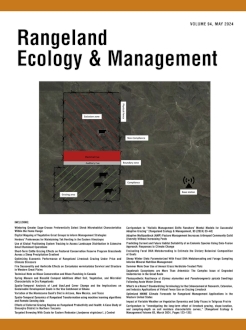Tallgrass prairie is one of the major ecosystems in the Southern Great Plains of the United States of America (USA). We investigated the impact of diverse weather conditions on the vegetation dynamics obtained through satellite remote sensing and the dynamics of carbon dioxide (CO2) fluxes, evapotranspiration (ET), and ecosystem water use efficiency (EWUE) obtained through eddy covariance (EC) in a native tallgrass prairie pasture in central Oklahoma, USA. The study was conducted from 2019 to 2022, considering varying growing conditions. Daily peak net ecosystem CO2 exchange (NEE), gross primary production (GPP), and ET were –8.7 g C m–2, 15.1 g C m–2, and 5.9 mm, respectively. Dynamics of eddy fluxes aligned with the dynamics of vegetation, indicating the accuracy and reliability of satellite-based vegetation indices in tallgrass prairie. Both CO2 fluxes and ET rates showed little variation over the years during the non-growing season (November to March). However, eddy fluxes exhibited diverse patterns during growing seasons. During the regrowth phase after the hay harvest, the differences in eddy fluxes were particularly substantial due to large variations in late-season rainfall. Consequently, the strength and duration of carbon gain during growing seasons varied substantially by year (i.e., carbon sink for 6 mo in 2019 vs. 2 mo in 2022). The highly variable magnitude of EWUE over the years illustrates that EWUE is not a constant property of this prairie ecosystem. A greater reduction in GPP than ET during dry years led to reduced EWUE. Strong relationships between eddy fluxes and vegetation indices suggest that CO2 fluxes and ET can be estimated from satellite imagery alone for tallgrass prairie across large spatial scales. Overall, this study provides valuable insights into the carbon and water cycles of tallgrass prairie and the impacts of environmental drivers and disturbances on their function.
BioOne.org will be down briefly for maintenance on 12 February 2025 between 18:00-21:00 Pacific Time US. We apologize for any inconvenience.
How to translate text using browser tools
17 May 2024
Impact of Variable Weather on Vegetation Dynamics and Eddy Fluxes in Tallgrass Prairie
Pradeep Wagle,
Brian K. Northup,
Corey Moffet,
Stacey A. Gunter
ACCESS THE FULL ARTICLE

Rangeland Ecology and Management
Vol. 94 • No. 1
May 2024
Vol. 94 • No. 1
May 2024
CO2 fluxes
drought
Ecosystem water use efficiency
evapotranspiration
southern Great Plains




